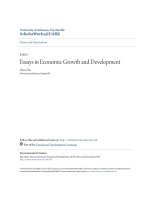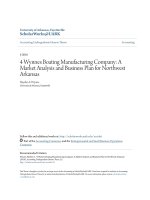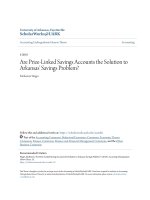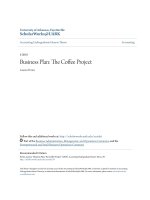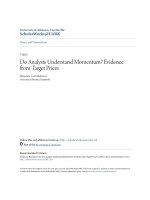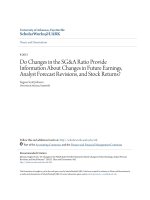Accounting undergraduate Honors theses: How does music consumption impact the music industry and benefit artists?
Bạn đang xem bản rút gọn của tài liệu. Xem và tải ngay bản đầy đủ của tài liệu tại đây (900.16 KB, 43 trang )
University of Arkansas, Fayetteville
ScholarWorks@UARK
Accounting Undergraduate Honors Theses
Accounting
5-2016
How Does Music Consumption Impact the Music
Industry and Benefit Artists?
Benjamin Fly
University of Arkansas
Follow this and additional works at: />Part of the Accounting Commons, Arts Management Commons, and the Sales and
Merchandising Commons
Recommended Citation
Fly, Benjamin, "How Does Music Consumption Impact the Music Industry and Benefit Artists?" (2016). Accounting Undergraduate
Honors Theses. 20.
/>
This Thesis is brought to you for free and open access by the Accounting at ScholarWorks@UARK. It has been accepted for inclusion in Accounting
Undergraduate Honors Theses by an authorized administrator of ScholarWorks@UARK. For more information, please contact ,
How Does Music Consumption Impact the Music Industry and Benefit Artists?
By
Benjamin Mark Fly
Advisor: Katie Terrell
An Honors Thesis in partial fulfillment of the requirements for the degree of Bachelor of Science
in Business Administration in Accounting
Sam M. Walton College of Business
University of Arkansas
Fayetteville, Arkansas
May 2016
Project Abstract
With the introduction of digital music in the 1990s, it internet-based music consumption
has become significantly simpler and increasingly more popular as more and more consumers
are streaming, sharing, and discovering new music all across the globe. With this new
development of digital music, the dynamics of the music industry have been affected
dramatically both in terms of record sales and the way music listeners are consuming music.
Unfortunately, with the rise of music in its digital format came the rise of illegal file sharing
sites, causing many to believe that the music industry was headed for its impending destruction.
However, legal online purchasing services and the more recent surge of streaming services like
Spotify and Pandora have added an additional element to the structure of music consumption.
Despite some of these negative effects that the digital format of music has had on the industry,
perhaps it is just this increased discoverability and accessibility that has encouraged the rising
popularity of live music. The purpose of this project is to understand the methods and relevant
trends of music consumption, determine those benefits received by the artists, and provide
guidance to artists about the rapidly changing dynamic of the industry.
2
Introduction
“No artist will be able to survive to be professionals except those who have a significant
live business, and that’s very few,” Hartwig Masuch, chief executive of BMG Rights
Management (as cited in Sisario, 2013).
With new music formats has come the ability to consume and discover music more easily
and at higher velocities. The changing tastes and preferences of consumers have an incredible
impact on the industry as a whole. In addition to the way music consumption has changed, so has
the way in which artists receive compensation. In many cases, the prominence of the royalty is
changing dramatically in response to the new era of streaming as a relevant method of music
consumption. Instead of only receiving a percentage of record sales or radio revenues, artists are
now entitled to collect their earnings based on the number of plays they receive from each
streaming service. But, royalties and streaming revenue are not the only ways that an artist is
able to make money. In order to more greatly understand how artists are able to indirectly benefit
from this increase in accessibility, this project will study some of the revenue streams, such as
live music sales, that come with an artist’s rising popularity.
Through an analytical approach, this project will address three major topics. First, how
has each relevant media format impacted the music industry in terms of record sales? With this
background information, this project will more comprehensively be able to explain what the
industry can expect when a new format is introduced. Second, how have these new formats
impacted music accessibility, and can that information provide insight as to how live music sales
are growing? By understanding the indirect effects of increasing knowledge and artist discovery,
is there a connection that has generated larger ticket revenue? Third, how have these innovations
impacted artists in terms of revenue generated from record sales and live music sales? In other
words, have these new formats and music sharing capabilities been a positive change in the
3
music industry, or are artists suffering the consequences of the industry’s changing preferences?
With an analysis of the relevant data and literature, this project will answer these questions and
provide guidance on successfully marketing and selling music.
Project Outline
This paper will proceed with in the following format. Section one begins by analyzing the
impact each media format has had on the music industry as it applies to generated revenue and
music consumption. Section two consists of a data review of the relevant information regarding
recorded music revenues varying by each format of music. This analysis is broken up into
multiple time periods in order to see which formats had the most significant influences on the
industry. Section three discusses artist compensation in order to understand how artists generate
their income, specifically identifying the most significant sources of income. Section four
discusses the impact of the diversity of formats in the recorded music industry on the live music
sector. Lastly, the project concludes by providing a brief overview of the information presented
and delivers guidance based on the findings over the course of this project.
Methodology
The majority of the recorded music industry data was obtained by examining the
Recording Industry Association of America’s North American Shipment Database, identifying
specific time periods and selected formats. The data was collected from the perspective of total
revenue levels and total units purchased from year to year and percentages of sales and
percentages of units sold relative to the overall level of respective annual revenues and unit sales.
Additional literary sources including online journal articles, online interviews, and additional
web sources were used in order to obtain critical primary and secondary quality sources when
reviewing the relevant literature. The financial data used to compare Spotify, Pandora, and Live
4
Nation was obtained from Statista, a statistics portal with data from more than 18,000 sources.
The data pertaining to North American concert sales since 1990 was obtained from Pollstar, a
music-oriented, collaborative database specializing in entertainment information.
5
Section I: Overview of the Recorded Music Industry
The Pre-Digital Era
In the post-World War II era, the most popular medium in record production was
polyvinyl chloride, also known as “vinyl” (Taintor, 2004). Simply put, vinyl became the most
prevalent choice for consumers with regards to affordable means of owning and playing music. It
was in 1948 that Columbia and RCA, rivals in the industry, began to make vinyl ownership
mainstream (Taintor, 2004). With the introduction of Columbia’s 33 1/3 rpm record and RCA’s
7-inch disc, the methods of producing and distributing affordable music became more possible
(Taintor, 2004).
The late sixties brought about the significant popularity of the cassette as a means of
record production. In fact, towards the end of the 1960s, while holding roughly the same amount
of information as the $6 vinyl, a blank cassette was sold for around $3 (Taintor, 2004). It was
with this innovation that record companies began to worry about the cassette as a potential
disruption in the level of vinyl sales. This is because a blank cassette would allow consumers to
create many bootleg recordings of their previously purchased vinyl record without actually
having to purchase more music. But, it was during this period of growing popularity for the
cassette that vinyl was facing a more threatening competitor.
With the introduction of the 8-track in the mid-1960s, consumers now had the ability to
theoretically record twice as much music as was possible with the blank cassette. In addition,
with its portability and more accessible use, it quickly became an accepted format for music
consumption. Claiming 25 percent of all music industry revenue in 1974, it seemed as though the
8-track was the fastest growing format in the industry (Recording Industry Association of
America [RIAA], 2016). However, the 8-track soon faced some challenges. For example,
6
manufacturers would often rearrange tracks of the vinyl in order to make the programs of the 8track equal length (Taintor, 2004). Additionally, in the case where a song would not fit on one
side of the program, the 8-track would abruptly stop in the middle of a track, and pick up again
once the listener had switched the track (Taintor, 2004). But perhaps the most significant
disadvantage of the 8-tracks’ capabilities was the difficulty of recording other music. Being
confined to the eight tracks after which the format was so famously named, the 8-track failed to
provide the same ease of duplication that quickly became the norm with blank cassettes. With
this being said, while the 8-track was capable of producing a higher quality sound than its
counterpart cassette, and provided more versatility than vinyl, it essentially disappeared from the
market in 1982 (RIAA, 2016). This is important to note because it is one of the first indicators of
the music industry being a subject of the market’s tastes and preferences. Clearly, convenience
and versatility were significant factors when determining value to consumers of music.
In the early 1970s, the music industry became frustrated with ‘bootlegging,’ or illegally
recording vinyl audio or radio broadcasts onto programmable cassettes. The largest argument
was from record companies claiming that teenagers were hurting record sales by taping audio
and swapping albums instead of purchasing physical copies of the albums (Taintor, 2004).
Record companies pushed for an additional tax to be placed on blank cassettes in order to
regenerate some of the lost record sales from bootleggers. After voicing this frustration, the U.S.
Congress passed the 1971 Sound Recording Amendment to the 1909 Copyright Statute (Taintor,
2004). It was not until the late 1970s that music sales actually began to slide, falling 11 percent
between 1978 and 1979, and failing to reach the previous high of $4.1 Billion until 1984 (RIAA,
2016). Though, the decline in the industry at that time may have been a result of the economic
recession of the late 1970s. In addition, with the introduction of the Sony Walkman in 1979, and
7
the increasing sound quality of the cassette, the cassette quickly became the most widely used
music listening format in 1983 with nearly half of all recorded music industry revenue (RIAA,
2016). It was this change in the music industry that caused the Record Industry Association of
America to lobby and convince legislators to grant a percentage of blank cassette sales back to
music labels.
Just as the cassette had revolutionized the vinyl-dominated music industry of the 1950s
and 1960s, a new format was introduced in the late 1980s. According to Callie Taintor, “With
the introduction of the Compact Disc (CD), the ‘80s become the most explosive boom in
recorded audio history, as consumers replace their vinyl collections. Within three years of the
CD’s arrival in the marketplace, the electronics industry sells one million CD players” (2004). In
fact, in 1987, record sales from the CD finally surpassed those from the declining vinyl format.
This is an important innovation in the music industry as it again proves the consumer’s power in
influencing the way music is recorded and sold.
This same power was displayed when the market refused to accept the Digital Audio
Tape (DAT) in 1987. A largely unmemorable format, the DAT offered excellent sound quality,
even when compared to the CD. However, one reason the music industry was hesitant to accept
this format was because of its capability of near perfect duplication (Taintor, 2004). Again, in
order to make up for these lost sales, record labels felt that it was necessary to receive a royalty
from every DAT player sold (Taintor, 2004). This claim was met with much debate, and as time
passed, the music industry began to believe that the DAT was not the format of the future. With
that in mind, record labels simply did not record music on the DAT. Because this format lacked
the accessibility as demanded by consumers and the profitability record labels desired, the DAT
never became a significant factor in the music industry.
8
The Digital Era
From the beginning of the 1990s, and into the early 2000s, the CD consistently
contributed the largest percentage of sales to overall revenue levels of the recorded music
industry (RIAA, 2016). Being superior in nearly every way for the average consumer, there
simply was no reason to prefer another form of music consumption. But the late 1990s were a
revolutionary period of innovation for the music industry, as it brought about the relevance of
music in its digital form. It was from a combination of the internet and digital audio recording
that the MP3 was born. With the development of the internet and the growing pressures from
consumers to be better, faster, and smaller, it only seemed logical that the music industry would
see this new option of consumption. Because of its ease of use, duplicative abilities, range of
selection, and accessibility, the MP3 was attractive in the eyes of consumers. Being that MP3s
are cut into individual songs, consumers could now select which songs they most desired,
without having to purchase a full-length album. In addition, because of their availability,
consumers were able to download music immediately from their computers. With the recorded
music industry peaking at its highest overall revenue level in 1999, it was exciting to have such a
fresh and new format in the market.
However, with this new capability, music sharing and piracy became a larger concern of
the record labels, and in response, the Audio Home Recording Act of 1992 was created. This act
essentially imposed a two percent royalty on digital audio recorder manufacturers to be paid to
copyright holders to make up for the lost sales from the increasing ease of piracy (Taintor, 2004).
On that note, the late 1990s brought about one of the largest piracy battles facing the music
industry. It was apparent that piracy and illegal music sharing was having a negative effect on
the music industry, and the MP3 was only making it worse. After a number of RIAA member
9
labels successfully won a lawsuit with Napster in 2001, a new void was created in the market for
internet music consumption. Where so many consumers had become familiar with internet
downloads, there was a desire for a legal purchasing service. This is important, because it is in
response to this fact that iTunes was created in 2003. In her web page from 2004, Callie Taintor
claims, “In its first year, Apple (sold) 70 million songs at $0.99 per song, creating nearly $70
million in legal Internet music sales.” At this time, the industry was not sure how this new
market would affect the revenues generated by physical media. What was clear, however, was
that legal purchasing services allowed the MP3 to quickly grow into one of the mainstream
formats of music consumption. In fact, according to the RIAA data, MP3 unit sales surpassed all
other formats in the music industry in 2007, just 6 years after its legal relevance (RIAA, 2016).
Yet despite the wild success of the MP3, a number of consumers did change their spending
habits, and physical media formats did begin to suffer. The recorded music industry has been in
decline since its peak in 1999 (RIAA, 2016).
The Streaming Era
The digital era, like all periods before it, sparked a redesign of recorded music industry’s
revenue structure. CDs and other physical media continued to decline as the new, popular MP3
became the favorite. While it seemed that the MP3 was as attractive to the average consumer as
music could legally be, the mid-2000s introduced an interesting concept of music consumption.
With internet speeds and technological familiarity increasing rapidly, developers saw the
opportunity to deliver music in yet another form. Similar to its digital counterpart, streaming
allowed consumers to listen to music without having to download the songs to a computer or
device. The music was simply delivered to consumers as a continuous stream of data. Through
ad-supported or paid subscriptions, consumers had the opportunity to listen to more music for a
10
fraction of the cost of any other format. The only real disadvantage of streaming to the average
consumer was that there was no transfer of ownership of the music being consumed. It was with
this fact that many questioned the success of streaming as a relevant format in the recorded
music industry. But because of its attractive qualities including accessibility to large libraries of
music, inexpensiveness, ease of use, and portability, streaming too became mainstream. More
recently, by the early 2010s, streaming became the fastest growing music format in the recorded
music industry (“Streaming Music Revenue,” 2015). While the recorded music industry has
plateaued since 2009, it is clear that streaming is having an effect on all preceding formats.
Considering the current freeze in revenue levels and the three major contributors to the music
industry, streaming is the only growing format today. Coupled with the recent resurgence of
vinyl as a relevant media format, the music industry is currently facing its most diverse time in
history with regard to the number of formats surpassing $100 million in annual revenue. It is
with this being said that the question remains for those involved in the production of music. How
do these recent changes in the music industry actually affect the greater music industry,
including live music sales, and how do these changes affect those artists responsible for making
this industry possible?
11
Section II: Data Analysis
With this brief overview of the history of the recorded music industry in mind, it is clear
that the music industry and its consumers have a definite impact on the innovation of new
formats. Unfortunately, it is a commonly held belief that the music industry has recently been
negatively affected by the rise of music in its digital format. Looking at the overall revenue
levels of the recorded music industry, that accepted belief rings true. Since the introduction of
music sharing in the late 1990s, there has been a significant decline in the overall revenue levels
of recorded music (RIAA, 2016). According to the RIAA music database, after peaking at $14.6
billion in 1999, the recorded music industry has generally declined to $6.9 billion in revenue in
2014 (RIAA, 2016). That is a 53 percent decline in fifteen years, without considering the effects
of inflation. Additionally, when the revenue of recorded music is converted into the equivalent of
the value of dollars from 2014, the data still shows a peak in the music industry in 1999 (RIAA,
2016). However, with the adjustment, the music industry theoretically peaks at $20.7 billion in
revenue (RIAA, 2016). With the consideration of inflation, going only fifteen years back the data
shows that overall revenue level of recorded music has decreased even more significantly-approximately 66 percent. Because of this, it is clear that the recorded music industry is losing
revenue. But there are a number of other factors to consider when evaluating the overall state of
the music industry. Figure 1 below is an illustration of the overall recorded music industry
adjusted for inflation between 1973 and 2014.
12
Music Industry Overview 1972-2014 Adjusted for
Inflation (In Millions)
$25,000
Synchronization
On-Demand Streaming
(Ad-Supported)
Paid Subscription
$20,000
SoundExchange
Distributions
Ringtones & Ringbacks
Download Music Video
Kiosk
$15,000
Download Album
Download Single
SACD
DVD Audio
$10,000
Music Video
Other Tapes
8 - Track
$5,000
Vinyl Single
Vinyl
Cassette Single
Cassette
$-
CD Single
CD
Figure 1: Overview of music industry sales. Generated from RIAA, Copyright 2016 by RIAA.
The Pre-Digital Era
Beginning in 1973, the popular format in music consumption was vinyl. In terms of
overall revenue generated, vinyl remained the most successful format of music until 1984, when
it was surpassed by the cassette (RIAA, 2016). However, despite losing its grip on the top
position, vinyl sales did not lose relevance until the early 1990s (RIAA, 2016). It was during this
time of vinyl relevance that the music industry grew with each year. Furthermore, the only time
the industry dipped during the pre-digital era was in the late 1970s and the early 1980s. While
13
many of the music industry giants attributed these decreases in revenue in 1980 and 1982 to the
ease of duplication and bootlegging offered by the growing cassette, it should also be noted that
during this time, the globe was experiencing a severe economic recession. By analyzing the
growth of vinyl and the cassette between 1979 and 1981, the data shows that the two formats
grew together in terms of revenue created (RIAA, 2016). However, 1981 marked the beginning
of the end of relevance for vinyl. Every year after 1981 showed a decrease in revenue generated
until finally falling below $100 million in sales in 1991 (RIAA, 2016). Regardless of the
recession that struck in the late 1970s and early 1980s, there is substantive evidence to suggest
that the cassette was responsible for the death of vinyl.
Just as vinyl continued to lose revenue during the 1980s, cassette sales rose to
compensate for the difference. After examining Figure 2 below, showing just vinyl and cassette
revenue in the period from 1981 to 1989, it is worth noting that the revenue levels from just these
two formats stayed between $3.7 billion and $4.2 billion (RIAA, 2016). To establish the context
of this fact, during the same period, the recorded music industry, including all available formats,
experienced revenue levels ranging between $4.0 and $6.6 billion (RIAA, 2016). In essence, it
was during this time that the cassette replaced vinyl as the most popular format of music
consumption. About eight years after its relevance, in 1984, cassette claimed nearly 55 percent of
the revenue in the recorded music industry, officially claiming dominance over vinyl (RIAA,
2016). But 1984 also proved to be an important year for what would soon be a serious competitor
in the music industry. Figure 2 and Figure 3 below illustrate the competition between vinyl and
cassette during the 1980s and a comparative overview of recorded music industry sales in 1984,
respectively. Figure 3 also highlights the relevant beginning of a new format in 1984.
14
Vinyl vs. Cassette 1981-1989 (In Millions)
$4,000
$3,500
$3,000
$2,500
$2,000
Cassette
Vinyl
$1,500
$1,000
$500
$1981
1982
1983
1984
1985
1986
1987
1988
1989
Figure 2: Vinyl and cassette comparison between 1981-1989. Generated from RIAA, Copyright 2016 by RIAA.
Comparitive Overview of Music Industry Sales
1984 (In Millions)
Vinyl Single, $298.7
CD, $103.3
LP/EP, $1,548.8
Cassette, $2,383.9
Figure 3: Overview of industry sales in 1984. Generated from RIAA, Copyryght 2016 by RIAA.
15
Just one year after being introduced to the music industry as a purchasable music format,
the CD generated $103 million in sales in 1984 (RIAA, 2016). Between 1984 and 1989, CD
sales rose from $103 million to nearly $2.6 billion (RIAA, 2016). However, perhaps a more
significant piece of information is that by 1990, the CD was the only growing format in the
recorded music industry. By 1991, the CD claimed a title it would hold for many following
years—the largest revenue generating format in the recorded music industry. Reacting just as
vinyl had when confronted by the cassette, the cassette itself soon began its gradual decline in
1992. Unlike the death of vinyl however, the rise of the CD was so large that between 1989 and
1999, the overall level of revenue attributable to just cassette and CD more than doubled from
6.1 billion to 13.9 billion (RIAA, 2016). Below, Figure 4 illustrates the rapid growth of the
industry that came with the popularity of the CD.
CD and Cassette 1989-1999 (In Millions)
$16,000
$14,000
$12,000
$10,000
Cassette Single
$8,000
Cassette
CD Single
$6,000
CD
$4,000
$2,000
$1989
1990
1991
1992
1993
1994
1995
1996
1997
1998
1999
Figure 4: CD and cassette growth between 1989 and 1999. Generated from RIAA, Copyright 2016 by RIAA.
Not only did the CD continue to grow from the mid-1980s until the early 2000s, it
dominated the industry. In fact, after the CD first claimed the largest share in 1991, over 55
16
percent of total revenue, it went on to generate nearly 96 percent of the recorded music
industry’s sales in 2002—by far the largest percentage of any formats in the history of the recent
industry (RIAA, 2016). The CD also made history in 2000 when it generated $13.2 billion in
revenue, alone (RIAA, 2016). This was, and still is, the largest amount of revenue generated by
any format in any year. It is important to understand the magnitude of this fact in order to begin
analyzing the driving forces behind the popularity of this format. Figure 5 below illustrates the
dominance of the CD on music industry sales in 2002.
Comparitive Overview of Music Industry Sales
2002
CD
CD Single
Cassette
Cassette Single
Vinyl
Vinyl Single
96%
Music Video
DVD Audio
Figure 5: Comparitive overview of music industry sales in 2002. Generated from RIAA, Copyright 2016 by RIAA .
The CD’s Dominance
Entering into a market with two already established formats accounting for nearly 100
percent of the industry’s revenue, the CD was faced with the difficult task of competition. In
order to be successful, the CD had to prove that it was better than both cassette and vinyl. With
this in mind, the CD started with a distinct advantage — duplication. One of the most attractive
17
characteristics of the cassette was its ease of duplication. Although cassette could not record
music with as high of quality levels as vinyl, the ease of duplication, portability, affordability,
and accessibility made it inherently better for the general music consumer. As expected, when
the CD arrived on the scene, it brought a number of qualities that were unique to this new format.
In terms of duplication, the CD was capable of near perfect duplication. This is significant
because it took one of the cassettes most attractive assets and did it better. Along those lines,
with the ability to skip and start specific songs exactly when they appear in the album, users no
longer had to fast-forward or rewind their cassettes, constantly checking to see if they had
reached the correct destination. In addition, the CD initially provided a more durable form of
consumption. Where fast-forwarding and rewinding was damaging to cassettes, causing some
records to become unlistenable, the CD offered more damage-resistance. In addition, as CD
players were developed for home stereos, cars, and other methods of portable consumption, the
CD became easier to use than the cassette. Simply put, the CD was better than the cassette in
nearly every way. With this in mind, tied with the RIAA database supporting the CD’s
dominance, it is clear that consumers preferred this new format. Again, this is significant because
it indicates the consumer’s power to accept a format into the industry. While the CD dominated
the recent industry much longer than any other format, this consumer power was once again
revealed in the early 2000s. Additionally, by using a similar analysis, it is clear that the music
industry took a turn in 2004.
The Beginning of the Digital Era
It is commonly accepted that piracy has had an inverse effect on all revenue generating
formats of the music industry. Record companies and artists have battled illegal music sharing
sites and other means of prohibited duplication as long as piracy has been possible. In 1999, sites
18
like Napster became a serious threat to the health of the industry. Between 1973 and 1999, the
overall revenue levels of the industry increased nearly every year (RIAA, 2016). However,
seemingly in response to this new, “free” alternative, the music industry declined nearly 20
percent between 1999 and 2003 (RIAA, 2016). While the music industry was able to recuperate
some of those lost sales in 2004 with the introduction of legal music purchasing sites, the
industry’s revenue has declined with each year thereafter. Figure 6 below shows the impact of
piracy beginning after 1999 and the introduction of internet-based consumption with downloaded
digital music beginning in 2004 and streaming relevance beginning in 2010. Considering the
effects of inflation, the music industry has declined 66 percent since 1999 (RIAA, 2016).
Digital Era Overview Adjusted for Inflation (In
Millions)
Synchronization
$25,000
$20,000
On-Demand Streaming
(Ad-Supported)
Paid Subscription
SoundExchange
Distributions
Ringtones & Ringbacks
Download Music Video
Kiosk
Download Album
$15,000
Download Single
SACD
DVD Audio
$10,000
Music Video
Other Tapes
8 - Track
$5,000
Vinyl Single
Vinyl
Cassette Single
$-
Cassette
CD Single
CD
Figure 6: Digital era industry overview adjusted for inflation. Generated from RIAA, Copyright 2016 by RIAA.
Since the beginning of internet sales in the digital era, specifically since 2004 with the
introduction of legal music purchasing sites, the number of units purchased has told a different
19
story of the consumption dynamic in the music industry. Since the introduction of the MP3,
ringtones, and ringbacks as relevant music formats, there has only been one year that that the
number of units purchased has been lower than the 1999 peak of nearly 1.2 million units
purchased in the pre-digital era (RIAA, 2016). That is to say, with the introduction of the digital
music format, consumers have been purchasing more units of music with each passing year. In
fact, between 2004 and 2012, the digital album and digital single formats grew from only $184
million to $2.8 billion in total revenue (RIAA, 2016). More impressively, only three years after
its legal introduction, digital albums and digital singles accounted for nearly 47 percent of the
total units sold among all formats of music (RIAA, 2016). In 2012, digital music was the largest
contributor to the total revenue of the recorded music industry (RIAA, 2016). This is significant
because, for the first time since 1990, the CD was not the leading contributor to the overall
revenue of the recorded music industry. While it seemed inevitable that the CD would eventually
lose its shine, consumers made it clear that digital was the best format to fit their needs. To date,
the digital format claims the lion’s share of the music industry with 37 percent of the total
revenue generated (RIAA, 2016). Despite its defeat over the CD, it is important to note that in
the past couple of years, the recorded music industry has seen a plateau in overall revenue level.
This is important because there is a new format replacing the revenues of the declining CD and
digital downloads. This current trend shows that the format responsible for this plateau in
industry revenue is streaming.
The Streaming Era
Today, the only growing relevant format of music consumption is streaming. With the
CD’s decline beginning in the early 2000s and the digital format’s decline beginning in 2012, the
ability to convince consumers to spend more of their discretionary income on purchasing music
20
is becoming increasingly difficult. To the average consumer, while digital and streaming can
offer the same quality of product, the fact is that streaming offers a much larger selection at a
much more affordable cost. With the nearly infinite libraries of songs that streaming can provide
at any place and time, it is no surprise that streaming has so quickly been accepted as a relevant
format in the eyes of consumers. Just as the recorded music industry has adapted to each new
format depending on the preferences of consumers, streaming is finally beginning to prove itself
as one of the leading formats.
Despite the recent lull in the growth or decline of the overall revenue levels of the
recorded music industry, there has been a change in the dynamic of the number of users involved
in each format of the industry. To identify the formats considered to be streaming, RIAA
includes SoundExchange distributions (estimated payments in dollars to performers and
copyright holders for digital radio services under statutory licenses), paid subscriptions, and ondemand streaming (ad-Supported) as streaming (RIAA, 2016). However, there is no data in the
RIAA database indicating the number of units sold regarding SoundExchange distributions or
on-demand streaming. This is because streaming without a paid subscription does not transfer a
unit of music to the consumer. The consumer does not own anything related to the music
industry when using ad-supported streaming. Yet, the data behind paid subscriptions gives some
useful insight about the behavior of the larger streaming format. For example, Figure 7 below
indicates that in 2014, paid streaming subscriptions only accounted for 0.5 percent of the total
number of units sold (RIAA, 2016). However, that same category, paid subscriptions, accounted
for nearly 12 percent of the total revenue generated in the industry (RIAA, 2016). This is
important because it signifies the decision of many consumers to switch from digital to streaming
as a primary source of consumption. This is a trend that has been rising significantly since 2004.
21
More specifically, the streaming recorded music industry has grown from $6.9 million in 2004 to
nearly $1.9 billion in 2014 (RIAA, 2016). More recently, streaming has nearly doubled its
revenue earned since 2012, when streaming revenue levels were just over $1.0 billion (RIAA,
2016). Figure 8 below shows the growth of the recorded streaming sector since 2005.
Comparitive
Overview of Music
Industry Units Sold
2014
Comparitive Overview of Music
Industry Sales 2014
CD
CD Single
Cassette
Cassette Single
LP/EP
Vinyl Single
8 - Track
Other Tapes
Music Video
DVD Audio
SACD
Download Single
Download Album
Kiosk
Download Music Video
Ringtones & Ringbacks
Paid Subscription
SoundExchange Distributions
Synchronization
On-Demand Streaming (Ad-Supported)
Paid
Subscription,
11%
Paid
Subscripti
ons,
0.19%
Figure 7: Streaming units sold and percentages of revenue in 2014. Generated from RIAA, Copyright 2016 by RIAA.
Streaming Revenue 2005-2014 (In Millions)
$2,000
$1,800
$1,600
$1,400
$1,200
$1,000
$800
$600
$400
$200
$-
On-Demand Streaming
(Ad-Supported)
SoundExchange
Distributions
Paid Subscription
2005
2006
2007
2008
2009
2010
2011
2012
2013
2014
Figure 8: Streaming revenue since 2005. Generated from RIAA, Copyryght 2016 by RIAA.
22
Another factor influencing the performance of the music industry during this era was the
economic recession that took place most significantly between 2007 and 2009. In times of
economic hardship, consumers will generally spend less on unnecessary goods. While music is
certainly an important part of any culture, it is one category of goods that can be forgotten by
some consumers in times of recession. Unfortunately for the recorded music industry, that meant
that the recession would cause sales to fall even faster than the unwelcome downturn that began
in 2000. In 2007, for the first time in recorded music history, the industry declined by over 10
percent in one year (RIAA, 2016). The following three years, the industry declined even more
severely by 21 percent in 2008 and 12 percent in both 2009 and 2010 (RIAA, 2016). The effects
of the recession only heightened the declining popularity of recorded music in the eyes of
consumers. However, since the recession, revenue recorded music industry, unadjusted for
inflation, has been relatively stagnant, as streaming seems to fill the void created by the physical
and digital decline. Considering its timing of introduction and its relative less expensiveness, it is
no surprise that streaming has become one of the relevant sectors of the recorded music industry.
Clearly, the streaming sector is a significant format among consumers as a basis for
music consumption as it currently serves the fastest growing format in the recorded music
industry. Although this new possibility seems to have halted the growth or decline of the
recorded music industry, artists are concerned about the effects that rise from this recent change.
While many believe that streaming, along with many other factors coming from the digital era
are what are killing the industry, streaming may actually be the format that saves it. In order to
examine the probability for artists in relation to the new dynamic established by the industry, it is
important to consider the significant revenue streams available to artists.
23
Section III: Recorded Music Compensation
Pre-Digital Overview
Just as the music industry has changed dramatically over the years, so have the methods
of compensation for the artists that record the music. Regarding the profitability of recorded
music, prior to the streaming era, artists had most often been compensated by a portion of
physical media sales and royalties from licensed airplay. Physical sales, from the sale of vinyl,
cassette, cd, and other tangible forms of music, have all followed the same general structure of
compensation. Though moving through time, more characters involved in the production of
music has often meant smaller portions to be divided among the artists. According to an article in
Rolling Stone magazine titled “The New Economics of the Music Industry,” Steve Knopper, the
author, provides the details of how the revenue is divided amongst those involved. In his article,
Knopper talks to Josh Grier, a music-business attorney for artists such as Wilco and Ryan Adams
to see what happens to all of the money on an album listed for sale at $17.98 (Knopper, 2011).
When an album is sold, retailers, in order to make a healthy profit, will take about $5.40, or 30
percent of the suggested retail price (Knopper, 2011). About 91 cents of the price is allocated to
publishers and songwriters (Knopper 2011). Assuming the producer does not take a cut of the
revenue, artists and record labels are left with $11.67 to divide (Knopper. 2011). However, due
to the agreement between labels and artists, labels see about $9.74 in proceeds compared to the
$1.93 in royalties for the artists (Knopper, 2011). That means that for every record sale, the artist
takes home roughly 16 percent of sales. However, after packaging and other hidden costs, that
percentage can actually be closer to 11 percent for an established artist (Knopper, 2011).
Looking at another example of physical media sales, according to a BBC article by Natalie
Donovan, only 13 percent of the CD sales are actually received by the artists (Donovan, 2013).
24
